Related Research Articles
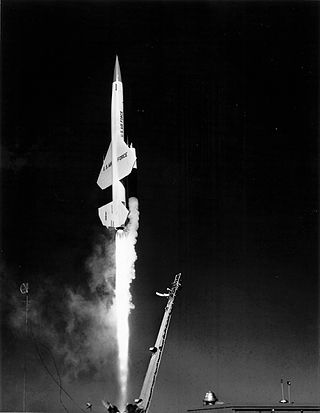
The Boeing CIM-10 BOMARC was a supersonic ramjet powered long-range surface-to-air missile (SAM) used during the Cold War for the air defense of North America. In addition to being the first operational long-range SAM and the first operational pulse doppler aviation radar, it was the only SAM deployed by the United States Air Force.

A ramjet, or athodyd, is a form of airbreathing jet engine that uses the forward motion of the engine to take in air for combustion that produces jet thrust. Since it produces no thrust when stationary ramjet-powered vehicles require an assisted take-off like a rocket assist to accelerate it to a speed where it begins to produce thrust. Ramjets work most efficiently at supersonic speeds around Mach 3 and can operate up to speeds of Mach 6.
The Curtiss-Wright Corporation is a manufacturer and services provider headquartered in Davidson, North Carolina, with factories and operations in and outside the United States. Created in 1929 from the consolidation of Curtiss, Wright, and various supplier companies, the company was immediately the country's largest aviation firm and built more than 142,000 aircraft engines for the U.S. military during World War II. Today, it no longer makes aircraft but makes many related components, particularly actuators, aircraft controls, valves, and surface-treatment services. It also supplies the commercial, industrial, defense, and energy markets; it makes parts for commercial and naval nuclear power systems, industrial vehicles, and oil- and gas-related machinery.

Elbert Leander "Burt" Rutan is a retired American aerospace engineer and entrepreneur noted for his originality in designing light, strong, unusual-looking, and energy-efficient air and space craft. He designed the record-breaking Voyager, which in 1986 was the first plane to fly around the world without stopping or refueling, and the Virgin Atlantic GlobalFlyer, which in 2006 set the world record for the fastest and longest nonstop non-refueled circumnavigation flight in history. In 2004, Rutan's sub-orbital spaceplane design SpaceShipOne became the first privately funded spacecraft to enter the realm of space, winning the Ansari X-Prize that year for achieving the feat twice within a two-week period.
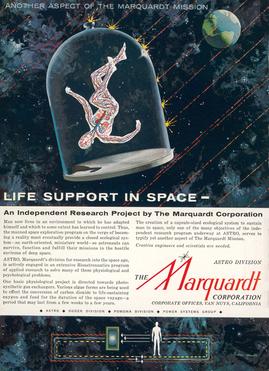
Marquardt Corporation was an aeronautical engineering firm started in 1944 as ‘’’Marquardt Aircraft Company’’’ and initially dedicated almost entirely to the development of the ramjet engine. Marquardt designs were developed from the mid-1940s into the early 1960s, but as the ramjet disappeared from military usage, the company turned to other fields.

The Northrop YB-35, Northrop designation N-9 or NS-9, were experimental heavy bomber aircraft developed by the Northrop Corporation for the United States Army Air Forces during and shortly after World War II. The airplane used the radical and potentially very efficient flying wing design, in which the tail section and fuselage are eliminated and all payload is carried in a thick wing. Only prototypes and pre-production aircraft were built, although interest remained strong enough to warrant further development of the design as a jet bomber, under the designation YB-49.
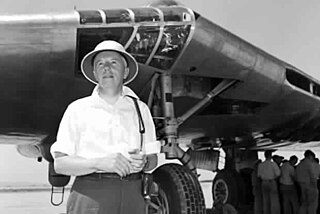
John Knudsen Northrop was an American aircraft industrialist and designer who founded the Northrop Corporation in 1939.

Edward Henry Heinemann was a military aircraft designer for the Douglas Aircraft Company.

Inlet cones are a component of some supersonic aircraft and missiles. They are primarily used on ramjets, such as the D-21 Tagboard and Lockheed X-7. Some turbojet aircraft including the Su-7, MiG-21, English Electric Lightning, and SR-71 also use an inlet cone.

An airplane, or aeroplane, informally plane, is a fixed-wing aircraft that is propelled forward by thrust from a jet engine, propeller, or rocket engine. Airplanes come in a variety of sizes, shapes, and wing configurations. The broad spectrum of uses for airplanes includes recreation, transportation of goods and people, military, and research. Worldwide, commercial aviation transports more than four billion passengers annually on airliners and transports more than 200 billion tonne-kilometers of cargo annually, which is less than 1% of the world's cargo movement. Most airplanes are flown by a pilot on board the aircraft, but some are designed to be remotely or computer-controlled such as drones.

The US Air Force's Aerospaceplane was a basic research project led by Weldon Worth at the Wright-Patterson AFB concerning the design of future recoverable spaceplanes. The effort was started in 1957 as a result of the USAF official SR-89774 for a reusable spaceplane. By 1959 this work was more known as the Recoverable Orbital Launch System (ROLS). It encompassed a variety of concepts, designs and research projects from 1958, but was cancelled as impractical in 1963.
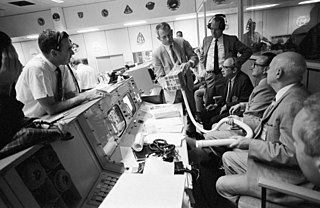
Aerospace engineering is the primary field of engineering concerned with the development of aircraft and spacecraft. It has two major and overlapping branches: aeronautical engineering and astronautical engineering. Avionics engineering is similar, but deals with the electronics side of aerospace engineering.
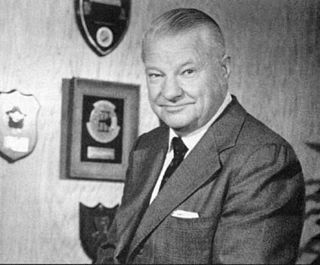
Clarence Leonard "Kelly" Johnson was an American aeronautical and systems engineer. He is recognized for his contributions to a series of important aircraft designs, most notably the Lockheed U-2 and SR-71 Blackbird. Besides the first production aircraft to exceed Mach 3, he also produced the first fighter capable of Mach 2, the United States' first operational jet fighter, as well as the first fighter to exceed 400 mph, and many other contributions to various aircraft.
Frederick Stucky Billig was an American aerospace engineer who was a pioneer in the development of scramjet propulsion.
Richard C. Scherrer (1919–2018) was an aircraft designer notable for pioneering work on revolutionary aircraft designs with extremely low radar cross sections that led to the Lockheed F-117 Nighthawk and Northrop Grumman B-2 Spirit.
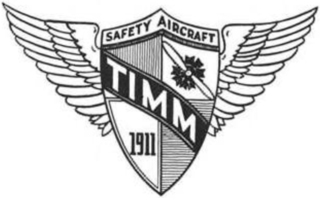
The O.W. Timm Aircraft Company was an American aircraft manufacturer founded by Otto William Timm, based in Los Angeles, California.

The Lockheed Martin SR-72, colloquially referred to as "Son of Blackbird", is an American hypersonic UAV concept intended for intelligence, surveillance and reconnaissance (ISR) proposed privately in 2013 by Lockheed Martin as a successor to the retired Lockheed SR-71 Blackbird. The company expected an SR-72 test vehicle could fly by 2025.
William Julius D. ("Bill") Escher was an aerospace engineer involved in the early development of the United States rocket programs and long time aerospace industry visionary. He was an internationally recognized expert in the field of high-speed airbreathing propulsion and hypersonic flight. He was a long been a proponent of combined-cycle propulsion systems for space access and his visionary 'Synerjet' concept is industry recognized. He wrote over a hundred technical papers on this subject and others such as hydrogen energy and lunar exploration.

The PTV-N-2 Gorgon IV was a subsonic ramjet-powered missile developed by the Glenn L. Martin Company for the United States Navy. Originally intended as an air-to-surface weapon, it materialized as a propulsion test vehicle, and between 1947 and 1950 was used for test purposes and, as the KDM Plover, as a target drone.
References
- ↑ "Roy Marquardt's passion for aviation took off from Burlington", Burlington, IA, The Hawkeye, December 24, 2017
- ↑ Jacobsmeyer, Jon Wallace, "The Marquardt Story" (an unpublished and partially completed manuscript recovered from the Internet Archives on 09 Oct 2016), Chapter One, pp 1 - 2
- ↑ "Models + Marquadt = Ramjets", Elizabeth, NJ, Air Trails Pictorial, Street & Smith Publications, Vol XXXII, No. 6, September 1949, p 24
- ↑ "Marquardt Honored", Van Nuys, CA, Remarqs - The Marquardt Corporation Quarterly Newsletter, Summer 1960, p 20
- ↑ "List of AIAA Fellows", Reston, VA, The American Institute of Aeronautics and Astronautics, 2018
- ↑ "47th Anniversary Honors and Awards Gala Banquet", Woodland Hills, CA, The Engineers' Council Souvenir Program, February 23, 2002, p 2
- ↑ Reflections, The Marquardt Corporation Twentieth Anniversary, The Marquardt Corporation, 1964, Tucson, AZ, The 41st AIAA/ASME/SAE/ASEE Joint propulsion Conference & Exhibit, 2005
- ↑ Jacobsmeyer, Chapter 1, Page 6
- ↑ "Marquardt Sales Drop", Pomona, CA, The Pomona Progress Bulletin, March 19, 1961, p 20
- ↑ Sweetman, Bill,"The Ramjet and the Rocket", Washington, DC, Air and Space Magazine, Smithsonian Institution, March 21, 1964
- ↑ "J. Montgomery Named Marquardt President and Chief Executive", New York, NY, The Wall Street Journal, December 7, 1964, p 12
- ↑ "Marquardt Says '65 Net Rose Despite Sales Lag", New York, NY, The Wall Street Journal, January 17, 1966, p 19
- ↑ "Marquardt Leaves Company He Began", New York, NY, The New York Times, August 11, 1967, p 44
- ↑ "Pioneer Jet Engine Builder Dies at 64", Los Angeles, CA, The Los Angeles Times, October 23, 1982